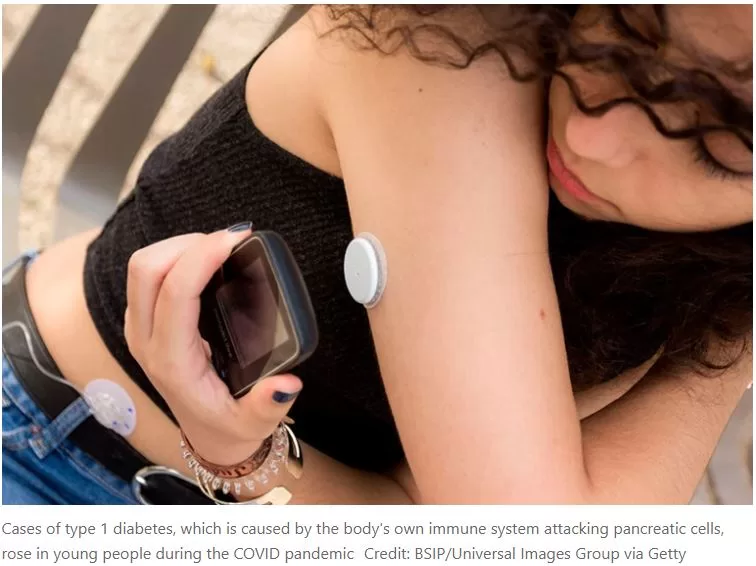A study of more than 38,000 young people has confirmed what researchers had begun to suspect: the COVID-19 pandemic precipitated a jump in cases of type 1 diabetes in children and teenagers. At first, researchers thought that the rise was caused by the virus itself — but it turns out that is probably not true. Nevertheless, with the overall cause of type 1 diabetes still a mystery, the findings offer new mechanisms for researchers to explore.
The study, published on 30 June in JAMA Network Open1, pooled data from 17 previous studies and found that the incidence of type 1 diabetes in children and teenagers under 19 years old was about 14% higher during 2020, the first year of the pandemic, than in the previous year. The incidence rose higher still in the second year of the pandemic, up 27% from 2019.
“It was a much higher incidence than we expected,” says senior author Rayzel Shulman, a paediatric endocrinologist at the SickKids Research Institute in Toronto, Canada. Before COVID-19, the incidence of type 1 diabetes in children was rising at a steady rate of around 2–4% a year.
“Now, all of a sudden, we see a tenfold increase,” says Clemens Kamrath, a diabetes researcher at Justus Liebig University in Giessen, Germany. “This is definitely a significant jump, to an extent and at a speed not thought possible.”
Seasonal waves
Type 1 diabetes occurs when the body’s own immune system attacks cells in the pancreas that produce insulin, which regulates blood sugar levels. As a result, blood sugar levels can seesaw dangerously. Over the long term, this can damage people’s blood vessels, which in turn can lead to blindness, kidney failure, heart attacks or nerve damage that in the worst cases requires limb amputation.
Researchers first raised concerns that COVID-19 might trigger type 1 diabetes after observing an upswing in new cases in multiple countries in the pandemic’s early months. Other research2 has also recorded a surge in new diagnoses of diabetes several months after a COVID-19 wave has peaked.
Yet numerous studies3,4 struggled to find evidence that SARS-CoV-2 was triggering the surge, or substantially harming the pancreatic cells5.
Shulman and her colleagues restricted their analysis to studies that had at least 12 months of data before and during the pandemic. They also included only those that reported the size of the population studied, not just case numbers — “so we could truly know if there was an increase in the incidence”, she says.
In addition to confirming that the incidence of type 1 diabetes in children rose during the first two years of the pandemic, they also found that the pandemic disrupted the seasonality of childhood type 1 diabetes. The illness usually follows clear seasonal patterns, with higher rates of new cases in winter than in summer months.
By contrast, the team was not able to analyse rates of type 2 diabetes in children, because there weren’t many studies with enough data. Type 2 diabetes develops when the pancreas doesn’t produce enough insulin and when the body stops responding to it. Inactivity and obesity are risk factors.
The meta-analysis did reaffirm that children diagnosed with type 1 diabetes tended to present with more severe forms of disease during the pandemic than before. The incidence of diabetic ketoacidosis, a potentially life-threatening complication of new-onset type 1 diabetes, rose by 26% from 2019 to 2020, probably because people were hesitant or unable to seek emergency care when early symptoms appeared. Diabetic ketoacidosis is preventable but has lasting effects if it does occur, so “that’s actually one of the most important findings from this study”, says Shulman.
Unknown causes
It’s still unclear what triggered the sudden increase in diabetes and how long the trend might persist, says Shulman. Longer-term studies are needed to see whether the incidence plateaus, falls or increases further, agrees Sathish Thirunavukkarasu, an epidemiologist studying diabetes at Emory University in Atlanta, Georgia.
But other researchers are not fully convinced by the findings. Lars Stene, an epidemiologist studying risk factors for type 1 diabetes at the Norwegian Institute of Public Health in Oslo, says a 14% jump in incidence in just one year “sounds implausible to me”. He says the incidence of the condition fluctuates a lot year-to-year anyway, and tenfold differences in incidence exist between the countries studied.
As for underlying causes, Kamrath, who wrote an invited commentary6 on the meta-analysis, says it now seems “rather unlikely” that SARS-CoV-2 is directly damaging pancreatic cells in children. Studies from Finland7, Scotland8 and Denmark9 could not directly link coronavirus infections to the increase in type 1 diabetes.
If the parallel pandemic of diabetes is not caused by the virus wiping out pancreatic cells, Shulman says, it opens up an opportunity for researchers to investigate other factors that might be driving the decades-long rise in childhood diabetes.
Thirunavukkarasu says the most probable explanation is that the immune system’s attack on the pancreas is “triggered by a COVID-19 infection, which happens with other infections as well, like enteroviruses and hepatitis B”.
He notes that the prevalence of a form of type 1 diabetes that develops without the immune system generating antibodies against people’s own cells has not changed during the pandemic. This suggests that the jump in youth type 1 diabetes is attributable to an increase in autoimmune attacks, brought about by environmental or lifestyle changes, Kamrath says.
It could be that the pandemic hastened the onset of type 1 diabetes in children already at risk, or that, for reasons unknown, more children are developing autoimmunity than before the pandemic, says Shulman. Lockdowns and physical distancing might have reduced kids’ exposure to respiratory viruses other than COVID-19, inadvertently removing some unknown protective effect, she adds.
Researchers are exploring other possible triggers, including diets rich in highly processed food, weight gain and changes in the immune-influencing microorganisms that live in the gut. “Diets are changing; obesity is increasing,” Thirunavukkarasu says, particularly in low- and middle-income countries, such as India and Bangladesh, where childhood diabetes burden was rising long before the pandemic. “There is no single answer for this.”
doi: https://doi.org/10.1038/d41586-023-02322-0
Source
https://www.nature.com/articles/d41586-023-02322-0#author-0











